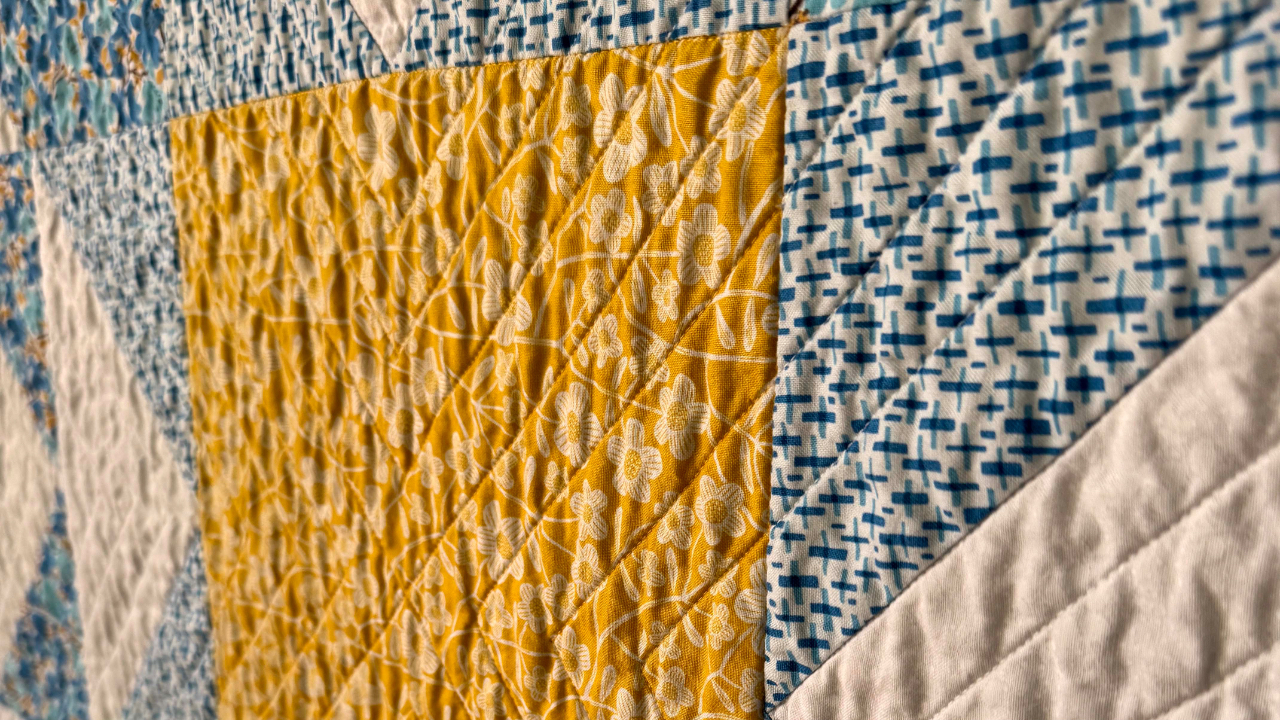
Updated July 6, 2025
Last month, I compared the features of three different rotary cutters and shared my opinions on them. I hope you've had a chance to try some for yourself and that your cutting mat and rulers are ready. Now, it's time to learn how to use your rotary cutter.
Supplies Recap
The complete list of supplies is in last month's post, but just as a reminder, you need:
- Rotary cutter
- Self-healing cutting mat
- Quilting rulers
- Fabric! (my personal favorite)

Preparing Your Fabric
Most quilting fabric is about 40 inches wide. Since we don’t have the tools or space to cut fabric this wide, you'll need to fold your fabric in half to fit the mat and ruler. I fold my fabric selvage-to-selvage for this. To ensure your cuts are on the grain, line up the selvages so that if there was a gap between them, they would be parallel. It's a bit frustrating to "waste" a strip of fabric like at the edge of this piece, but cutting on the grain really helps prevent fraying and stretching when you go to piece later.

Making the First Cut
The first cut you make with your rotary cutter is to square up the raw edge. Let me start by saying all measurements are made using the grids on your ruler and not your cutting mat. I repeat: Measure using your ruler, NOT your cutting mat. Cutting mats are marked with less precision than rulers, so that's one reason to use the ruler. Also, your fabric covers the mat, and the rulers are see-through. So, it makes sense to use the ruler, right?!
Align the ruler with the bottom, folded edge of your fabric. This will ensure you cut straight strips and avoid strips with a slight "V" shape.
Once your ruler is aligned, trim the raw edge of your fabric to straighten it.

Cutting Your First Strip
Remember, we will measure the width of your first strip using the markings on the ruler, not the cutting mat. Once you're sure your ruler is aligned correctly, make your next cut. You now have a perfectly cut 2 1/2-inch strip. Congratulations!

Cross-Cutting Your Strips
Now that you have your strips, it's time to crosscut them into squares. In the picture below, I've aligned my strip with the markings on the ruler and am ready to straighten the raw edge. You cut your squares the same way you cut your strips, but I wanted to include this picture to share an important tip: If your whole hand is on the ruler, the ruler will slip when you make your cut. There are all sorts of sticky rulers and adhesives to help them grip, but the physics (or some other magical science) is clear: if your whole hand is on the ruler, it will slip when you cut.
To avoid slipping, I make a weird "paw" with my hand and let my fingertips just fall off the ruler onto the cutting mat. This works for me every time. Every. Time..

Don't Just Take My Word for It
If you gather ten quilters in a room, I guarantee you'll see at least ten different ways to cut fabric with a rotary cutter. I've tried other methods over the years, but the one above is the one that works best for me. Keep experimenting with different rulers, cutters, and techniques until you find the one that's right for you.
I hope you learned something new today and that all your future cutting is fast, easy, and painless!






